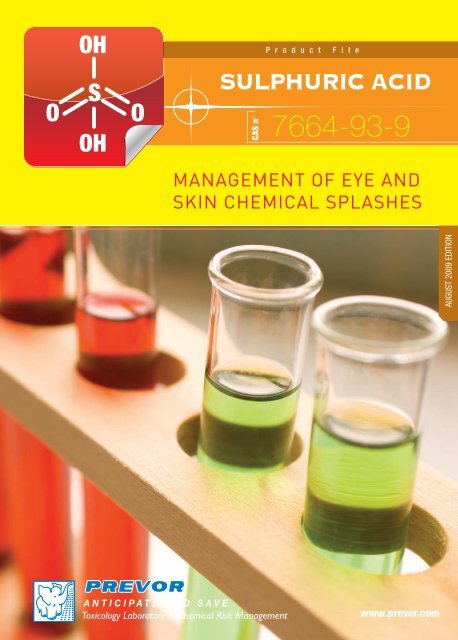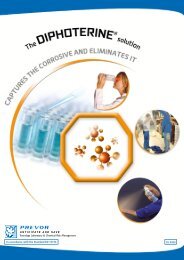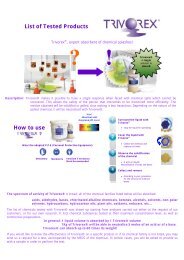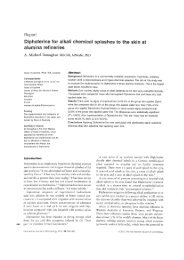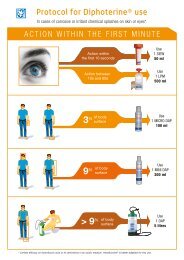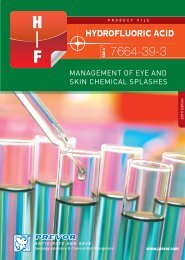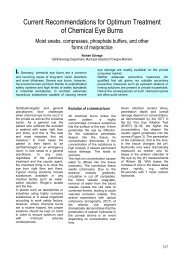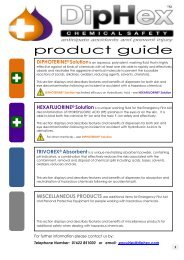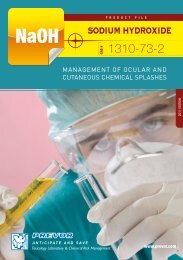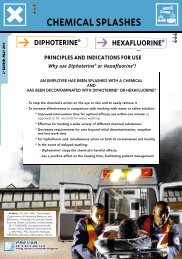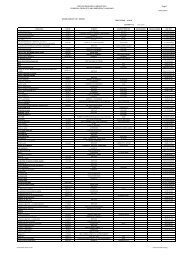Sulphuric Acid Booklet - DipHex
Sulphuric Acid Booklet - DipHex
Sulphuric Acid Booklet - DipHex
You also want an ePaper? Increase the reach of your titles
YUMPU automatically turns print PDFs into web optimized ePapers that Google loves.
O<br />
OH<br />
S<br />
OH<br />
O<br />
SULPHURIC ACID<br />
CAS n°<br />
P r o d u c t F i l e<br />
7664-93-9<br />
MANAGEMENT OF EYE AND<br />
SKIN CHEMICAL SPLASHES<br />
AUGUST 2009 EDITION<br />
www.prevor.com
C O N T E N T<br />
SULPHURIC ACID<br />
MANAGEMENT OF EYE AND<br />
SKIN CHEMICAL SPLASHES<br />
1. KEY POINTS p3<br />
1.1. Background p3<br />
1.2. Names p3<br />
1.3. Uses p3<br />
2. LABELLING p4<br />
2.1. Level of danger according to concentration p4<br />
2.2. Other classifications p5<br />
3. CHEMICAL CHARACTERISTICS p5<br />
4. CORROSIVITY OF SULPHURIC ACID p5<br />
4.1 Chemical Mechanisms p5<br />
4.2 Chemical injuries due to sulphuric acid p6<br />
5. MANAGING ASSOCIATED RISKS p7<br />
6. EMERGENCY RESPONSE TO SULPHURIC ACID SPLASH<br />
ON THE SITE OF THE ACCIDENT<br />
6.1. Evaluation of decontamination methods p8<br />
6.2. Experimental Evidence p10<br />
6.3. Feedback on the use of Diphoterine ® p12<br />
7. IN CONCLUSION, HOW SHOULD DIPHOTERINE ® BE USED? p14<br />
8. DOCUMENTS AND REFERENCES p16<br />
p8<br />
2<br />
MANAGEMENT OF EYE AND SKIN CHEMICAL SPLASHES
1. KEY POINTS<br />
1.1. Background<br />
<strong>Sulphuric</strong> acid has been known since the 8 th century; two main processes are used today to<br />
produce it from sulphur dioxide:<br />
- Catalysis<br />
- A « contact » process<br />
1.2. Names<br />
<strong>Sulphuric</strong> acid (or sulfuric acid in USA) is also called:<br />
1.3. Uses<br />
- Sulphur trioxide (in its solid form CAS 7446-11-9)<br />
- Oleum (anhydrous sulphuric acid saturated with CAS 8014-95-7 sulphur trioxide)<br />
- <strong>Sulphuric</strong> acid (in its liquid aqueous form CAS 7664-93-9)<br />
- Other name: vitriol or oil of vitriol (because of its glassy appearance).<br />
- "Battery acid"<br />
- Dihydrogen sulfate<br />
ACIDE SULFURIQUE<br />
Molecular Fo r m u l a<br />
H 2SO 4 (aq)<br />
Molar mass 98,08 g.mol -1<br />
CAS number 7664-93-9<br />
EINECS number 231-639-5<br />
ICSC number 0362<br />
INRS ( 1 ) FT n°30<br />
Widely used in industry (approximately 150, 000, 000 tonnes a year worldwide), sulphuric<br />
acid is used in fertilizers, textiles, chemical synthesis, detergents, dyes and colouring,<br />
explosives, paper, accumulators, surface treatments and the petrochemical industry.<br />
It is often the cause of chemical injuries 2 especially to the skin, the eyes, the respiratory tract<br />
and even the digestive tract.<br />
1 - Institut National de Recherche et de Sécurité (The French National Research and Safety Institute)<br />
2 - Flamminger A, Maibach H, Sulfuric <strong>Acid</strong> Burns (corrosion and acute irritation):<br />
evidence-based overview to management, Cut. Ocul. Tox, 2006, 25, 55-61<br />
SULPHURIC ACID<br />
3
2. LABELLING<br />
2.1. Level of danger according to concentration<br />
• EC classification in force until December 2010 for substances (until the end of June<br />
2015 for mixtures):<br />
Product included in 19 ème ATP (3) .<br />
SULPHURIC ACID HAZARD SYMBOL RISK PHRASES<br />
Pure (substance) C R35<br />
Concentration > or = to 15 % C R35<br />
Concentration from 5 to 15 % Xi R36/38<br />
Concentration from 0 to 4,99 % - -<br />
Risk phrases are given at the end of the document<br />
• New labelling according to CLP 4 regulation, in force from December 2010 for<br />
substances (from the end of June 2015 for mixtures):<br />
Danger !<br />
H314 - Causes severe skin burns and eye damage<br />
SULPHURIC ACID CLASSIFICATION HAZARD STATEMENT<br />
Pure (substance) Skin Corr 1A H314<br />
Skin Corrosion/irritation<br />
Hazard category 1A<br />
Concentration > or = to 15 % Skin Corr 1A<br />
H314<br />
Skin Corrosion/irritation<br />
Hazard category 1A<br />
Concentration from 5 to 15 % Skin Irrit 2<br />
H315<br />
Corrosion/irritation<br />
Hazard category 2<br />
Eye Irrit 2<br />
H319<br />
Serious eye damage/eye irritation<br />
Hazard Category 2<br />
C o n c e n t r ation from 0 to 4.99 % - -<br />
4<br />
MANAGEMENT OF EYE AND SKIN CHEMICAL SPLASHES<br />
Hazard statements are given at the end of the document<br />
3 - Adaptations to Technical Progress appendix 1 of the 1981 text see ECB<br />
4 - Classification Labelling Packaging - Regulation 1272/2008/EC
2.2. Other classifications<br />
UN Hazard Class : 8<br />
In the United States (5) : Code NFPA 704 : H : 3<br />
F : 0<br />
R : 2<br />
W : ---<br />
3<br />
0<br />
w<br />
2<br />
3. CHEMICAL CHARACTERISTICS<br />
A colourless liquid, more or less viscous depending on concentration; it has the capacity to<br />
form intermolecular hydrogen bonds.<br />
<strong>Sulphuric</strong> acid is miscible with any amount of water with an exothermic reaction.<br />
Molar mass 98,08 g.mol -1<br />
Boiling point 337°C<br />
Melting point<br />
10,31°C<br />
Vapor pressure Env 0,0001 mbar à 20°C<br />
TLV (6)<br />
1 mg/m 3 (VME)<br />
1 mg/m 3 ( T WA , NIOSH REL) ( 7 )<br />
1 mg/m 3 (TWA, OSHA PEL) (8)<br />
Density (20°C) 1,8305 g/cm 3 (100 %)<br />
1,8361 g/cm 3 (98 %)<br />
1,3028 g/cm 3 (40 %)<br />
1,1398 g/cm 3 (20 %)<br />
Source: 87 th edition of the Handbook of chemistry and physics -<br />
2006-2007 edition<br />
4. CORROSIVITY OF SULPHURIC ACID<br />
4.1 - Chemical Mechanisms<br />
<strong>Sulphuric</strong> acid corrosivity is due to a combination of four mechanisms:<br />
• the acidity itself (production of H + ions),<br />
• the dehydration caused by concentrated solutions,<br />
• the heat released by exothermic reactions,<br />
• the oxidizing nature of the chemical (concentrated or after warm-up).<br />
4.1.1 <strong>Acid</strong>ity<br />
<strong>Sulphuric</strong> acid can release 2 H + ions successively in an aqueous solution:<br />
H 2 SO 4 + H 2 O H 3 O + + HSO 4<br />
-<br />
pK 1 = -2<br />
HSO 4 - + H 2 O H 3 O + + SO 4<br />
2-<br />
pK 2 = 2<br />
Thus, for a molar concentration (1M), the corrosion potential of sulphuric acid is doubled.<br />
5 - According to the International Chemical Safety Cards WHO IPSC ILO<br />
6 - Threshold Limit Value<br />
7 - Recommended Exposure Limit for the National Institute for Occupational Safety and Health<br />
8 - Permissible Exposure Limit (for an 8 hour day as defined by the Occupational Safety Health Administration)<br />
SULPHURIC ACID<br />
5
<strong>Acid</strong>ity occurs also when sulphuric acid is used as a sulfonation agent:<br />
2H 2 SO 4 + H 2 O SO 3 + H 3 O + + HSO 4<br />
-<br />
4.1.2 Dehydration Properties<br />
Wat e r- f r e e , highly concentrated sulphuric acid solutions (above 95%) increase<br />
corrosivity. Indeed when it comes into contact with cellular biological fluids, the<br />
anhydrous product literally pumps out all the water, causing tissue necrosis.<br />
4.1.3 Exothermy<br />
In contact with water, sulphur trioxide produces sulphuric acid with heat release:<br />
4.1.4 Oxidizing Properties<br />
88 kJ<br />
SO 3 + H 2 O H 2 SO 4<br />
When concentrated and warmed up, sulphuric acid becomes an oxidant due to the<br />
following combination: SO 4<br />
2-<br />
/SO 2(aq) ( E0 = 0,93 V)<br />
Source: 87 th edition of the Handbook of chemistry and physics -2006-2007 edition<br />
2H 2 SO 4 + Cu<br />
SO 2(g) + CuSO 4 + 2H 2<br />
O<br />
4.2 - Chemical injuries due to sulphuric acid<br />
When concentrated sulphuric acid comes into contact with the skin or the eyes, the pain is immediate.<br />
The short term effects on the skin are coagulation-induced necrosis (dark greeny black/<br />
brown). In the eyes, the cornea becomes opaque. In the event of inhalation, there is a risk of acute<br />
(more or less delayed) lung oedema.<br />
In the medium and long term, there is a risk of invalidating physical side effects in cases of skin<br />
injuries, including retractile fibrosis and / or keloid scarring.<br />
In cases of chemical eye injuries, the risk of ocular perforation is significant. A chemical burn<br />
due to sulphuric acid can lead to definitive loss of the visual acuity.<br />
6<br />
Pictures from Dr Harold Merle<br />
Pictures from Dr Harold Merle<br />
MANAGEMENT OF EYE AND SKIN CHEMICAL SPLASHES<br />
Pictures from ASF
The severity of the chemical burn depends on concentration, which area of the body is affected<br />
and time of exposure.<br />
Besides corrosivity, there is also the issue of carcinogenic consequences.<br />
The IARC (9) classifies «aerosols and sulphuric acid and other strong inorganic acid mists » in group<br />
1 (confirmed carcinogenic to humans). There is a risk of sinus, larynx and lung cancer. The<br />
mechanism involved could be related to chronic irritations due to work-related exposure.<br />
5. MANAGING ASSOCIATED RISKS<br />
> Collective and Personal Protection (10)<br />
COLLECTIVE<br />
PROTECTION<br />
• Work in a sealed environnment<br />
• Capturing emissions at their source<br />
INDIVIDUAL<br />
PROTECTION<br />
• Gloves (see table below)<br />
• Anti-acid face-shield or goggles<br />
• Masks with filtrating cartridge for occasional uses<br />
• Protective clothes (apron, boots, etc…)<br />
9 - International Agency for Research on Cancer<br />
10 - Refer to full description in Toxicological Card n°30 of INRS<br />
SULPHURIC ACID<br />
7
Glove compatibility table<br />
LATEX NEOPREN NITRILE VINYLE<br />
CONCENTRATED<br />
SULPHURIC ACID<br />
DILUTED SULPHURIC<br />
ACID<br />
- = - +<br />
++ ++ ++ ++<br />
> Special Recommendations<br />
• Availability of decontamination materials on all work stations.<br />
• To be handled with care: never pour water into<br />
the acid. When dissolving or diluting, always add<br />
it slowly to the water, stirring constantly to avoid<br />
splashes and heating of substance.<br />
6. EMERGENCY RESPONSE TO SULPHURIC ACID SPLASH ON<br />
THE SITE OF THE ACCIDENT<br />
The effectiveness of immediate washing of chemical splashes determines the subsequent outcome<br />
of the chemical accident. Splashes must be rinsed immediately after exposure to avoid or<br />
reduce severity of burns.<br />
Ideally, one should seek to stop the substance's corrosive effect on the surface and prevent it<br />
from penetrating deeper into the skin or eye.<br />
6.1. Evaluation of decontamination methods<br />
Comparison of the standard method, t ap water flushing, with an active washing method,<br />
D i p h o t e r i n e ® w a s h i n g .<br />
8<br />
MANAGEMENT OF EYE AND SKIN CHEMICAL SPLASHES
6.1.1. Rinsing with water<br />
Water is polyvalent, it mechanically washes off the substance from the surface and at the same<br />
time dilutes it. Because of these properties at the surface of the tissue, water has been used as<br />
systematic and universal response. But water has its limitations. It must be applied immediately<br />
and in very large amounts. Despite an early washing with tap water, severe burns can appear,<br />
particularly in the case of concentrated corrosive substances. Thus this protocol can not be<br />
considered as constantly safe.<br />
As we have seen, rinsing anhydrous solution splashes with water generates heat which can<br />
aggravate the chemical injury. However, mechanical rinsing and dilution can help to rapidly<br />
contain and eliminate heat evolution.<br />
Since it has no effect on the corrosive potential of sulphuric acid, rinsing with water proves to be<br />
insufficient for high concentrations; this is illustrated by the following accident: walking down<br />
a corridor, a young female laboratory technician catches her open lab coat on a flask of<br />
concentrated sulphuric acid. The flask falls, breaks and spills splashing her leg that she<br />
rinses immediately with water. The injury heals then reoccurs over a course of several months.<br />
6.1.2. Decontamination with Diphoterine ®<br />
In view of these problems, an active decontamination compound retains the wash-off effect of<br />
water while optimizing the decontamination process, thanks to the management of sulphuric<br />
acid's aggressive potential.<br />
Washing with Diphoterine ® is the answer to these criteria of effectiveness.<br />
• its amphoteric properties ensure a rapid return to physiological pH values.<br />
• Diphoterine ® is a hypertonic solution that limits tissue penetration of the chemical.<br />
By creating a reverse flow, it can actually draw the chemical out of the tissues 11 .<br />
• Its multisite properties actually make it a highly effective decontamination method in all<br />
situations where sulphuric acid is used in combination with other irritant or corrosive<br />
chemicals.<br />
11 - Schrage NF, Rihawi R, Frentz M, Reim M, Akuttherapie von Augenverätzungen, Klin Monastbl Augenheilkd 2004, 221(4), 253-261<br />
SULPHURIC ACID<br />
9
6.2 - Experimental evidence<br />
The effectiveness of Diphoterine ® was compared experimentally to a passive tap water<br />
rinsing method via an in vitro simulation of a 95% sulphuric acid splash.<br />
The study showed the change in pH and in temperature of one millilitre of concentrated<br />
sulphuric acid in the presence of an increasing amount of water or Diphoterine ® . During<br />
this static experiment, i.e. without the mechanical effect of dynamic rinsing, the chemical<br />
activity was measured in order to evaluate the effectiveness of the Diphoterine ®<br />
rinsing, and more specifically, its amphoteric properties on a strong acid like sulphuric<br />
acid, versus water rinsing.<br />
The sample tested corresponds to 5 drops of sulphuric acid at 95%. 12<br />
Graph 1 : in vitro dosage - pH measurement<br />
Graph 1 shows the simple dilution of sulphuric acid in water and, ex contrario, the effect<br />
of Diphoterine ® on acidity with a faster return to an acceptable physiological pH<br />
level (>5.5) using a limited volume of 520 ml. It should be noted that for an equivalent<br />
amount of tap water, the pH (at approximately 1.5) remains very corrosive.<br />
1 0<br />
12 - On average, one drop is 20 µL. It is the maximum quantity which is able to remain on the corneal surface,<br />
whatever the quantity splashed, because of the blinking reflex as well as of the natural flow of the liquid.<br />
MANAGEMENT OF EYE AND SKIN CHEMICAL SPLASHES
In the same experiment a solvation effect of sulphuric acid in water was observed, leading to heat<br />
release of approximatively 90°C (graph 2 - static simulation).<br />
This effect rapidly diminishes during washing because the wash-off effect considerably reduced<br />
heat generation. The temperature, thanks to rinsing, only rises to 50°C, only for a few seconds,<br />
and rapidly returns to the temperature of the washing solution (graph 2 - simulation of external<br />
washing).<br />
Graph 2: temperature measurement- static simulation - simulation of external washing<br />
Graph 3 shows external pH changes over time. As in the static in vitro experiment, less<br />
Diphoterine ® (59 ml versus 150 ml of tap water) is required to achieve lower physiological pH<br />
values and in two and a half times less time.<br />
Graph 3: Simulation of external washing - Measurement of external pH<br />
SULPHURIC ACID<br />
1 1
6.3 - Feedback on the use of Diphoterine ®<br />
The following paragraph lists some cases on the use of Diphoterine ® to decontaminate eye<br />
or skin chemical splashes. This feedback shows that when Diphoterine ® is applied<br />
immediately, it stops the action of sulphuric acid, thus avoiding or minimizing the<br />
development of chemical injuries. The other consequence is the absence of after-effects and<br />
no need for sick-leave. When Diphoterine ® is used as a secondary response after rinsing with<br />
tap water, the chemical injury has already developed because water has failed to stop the<br />
action of the acid and has only diluted it on the surface tissues. Diphoterine ® can then be used<br />
to stop any further development of the injury as it also acts on any acid that might have<br />
already penetrated the tissues.<br />
February 1991 - La Quinoléine (Orgachim), Seine maritime - France<br />
This accident was reported in 1991 by Dr. F. Bourlon, the company medical officer at the time.<br />
Two workers dismantling pipes were splashed from head to toe with 98% sulphuric acid.<br />
They were immediately undressed and washed with Diphoterine ® , before being taken to<br />
hospital for further examination. They left hospital on the same day and did not require<br />
secondary care or sick-leave.<br />
1995 – Metalleurop Weser Zink GmbH, Germany<br />
Further to a technical fault during a routine test on a stock of acid, a technician was<br />
spattered on his face and neck with 96% sulphuric acid. Immediate rinsing with Diphoterine ® ,<br />
thus stopped the action of the acid, preventing burn injuries from appearing. The victim was<br />
able to go back to work immediately.<br />
1994-1998 - Series of cases at Mannesmann, Germany<br />
In a metal-working company, a series of chemical splashes occurred during the handling of<br />
acids and strong bases. The table below details eye and skin splashes from 20% sulphuric<br />
acid. All splashes were rinsed with Diphoterine ® on the site of the accident and with<br />
Diphoterine ® again in the company infirmary. The management of these splashes did neither<br />
require any secondary treatment nor sick-leave, and no sequelae did appear.<br />
1 2<br />
MANAGEMENT OF EYE AND SKIN CHEMICAL SPLASHES
Age Place on the body Secondary Lost work time Sequellae Circonstances<br />
where the splash occurred Care (days) of the splash<br />
22 right eye none 0 none Pickling :<br />
hanging a chain<br />
47 eye none 0 none Pickling :<br />
while filling an acid bath,<br />
ocular splash even<br />
ocular wearing<br />
protective goggles<br />
46 right eye none 1 none Pickling :<br />
was splashed,<br />
in the eye with acid<br />
while cleaning<br />
41 left eye none 0 none Pickling :<br />
while steam cleaning tiles,<br />
simultaneous splash<br />
of water and 20%<br />
sulphuric acid<br />
in the left eye<br />
41 right eye none 0 none Was splashed while<br />
putting pipes in<br />
an acid bath<br />
48 left eye none 0 none Was splashed<br />
while cleaning<br />
25 right cheek none 0 none Was splashed with a chemical<br />
while opening a valve<br />
26 torso none 0 none Pickling : was splashed<br />
with sulphuric acid<br />
while emptying a pipe<br />
25 face none 0 none Pickling<br />
27 right hand none 0 none Was splashed while<br />
handling acid<br />
July 1999 - Knoll AG (BASF PHARMA), Germany<br />
While collecting a sample, an operator was spattered on the cheek with a few drops of 96%<br />
sulphuric acid. The cheek immediately turned very dark red; the discoloration nearly entirely<br />
disappeared after being immediately rinsed with a Mini DAP of Diphoterine ® . The doctor noted no<br />
residual redness on examination. A cream was applied to the operator's face and he was able to go<br />
back to work.<br />
October 2004 - Teaching Hospital in Liège - Belgium<br />
During a maintenance operation, a young man using a pipe clearing product was splashed with a<br />
corrosive product on a leg and a forearm. One of the ingredients of the clearing product was 90%<br />
sulphuric acid.<br />
He was first rinsed with tap water, heightening the pain. Twenty minutes after the splash, the patient<br />
arrived in the casualties department of the hospital and was washed with a 200 ml Diphoterine ®<br />
aerosol spray. This immediately reduced pain. Rinsing was continued. The worker was kept in<br />
observation and went back to work later that day, without needing sick-leave.<br />
SULPHURIC ACID<br />
1 3
July 2005 - CMHI, Le Havre - France<br />
While working on a incompletely emptied valve, a pipe operator was splashed on the face, neck and<br />
right ear with 98% sulphuric acid. Water rinsing was delayed (about 5 mn later) and a severe burn<br />
immediately developed. Diphoterine ® was applied fifteen minutes later when the medical staff arrived<br />
on the site of the accident. After agreement of the occupational medicine officer and the intern in<br />
charge at the casualties department of the hospital, the patient continued to use Diphoterine ® for a<br />
period of 48 hours as a pain-killer. After 72 hours, the oedema was no longer visible. The complete<br />
healing of this burn without scarring was obtained after 29 days, even though the initial severity<br />
of the facial burn would normally have indicated a longer development, requiring more significant<br />
secondary care and possibly a graft.<br />
24h after the accident 72h after the accident 29 days after the accident<br />
7. IN CONCLUSION, HOW SHOULD DIPHOTERINE ® BE USED ?<br />
Diphoterine ® is a rinsing solution for emergency response to eye and skin chemical splashes. Thanks<br />
to its amphoteric properties, it acts directly on the irritant and corrosive potential of chemical agents.<br />
Because of its high osmolarity it stops any in-depth tissue penetration. This maximizes rinsing<br />
solution effectiveness, preventing or limiting corrosive lesions.<br />
1 4<br />
MANAGEMENT OF EYE AND SKIN CHEMICAL SPLASHES
In cases of eye or skin splashes with sulphuric acid, we strongly recommend performing<br />
a rapid and prolonged washing with Diphoterine ® .<br />
In the event of an eye splash with sulphuric acid where the length of contact is less than<br />
10 s, use a SIEW (50ml). In case of anhydrous sulphuric acid splash, we recommend to<br />
continuing the washing at the infirmary with 500ml of Diphoterine ® .<br />
For a length of contact between 10 and 60 seconds, use a 500 ml bottle or a 500 ml<br />
Portable Eyewash.<br />
It is advised to complement washing with a 200 ml container of Afterwash II ® .<br />
In case of skin splashes and a length of contact less than 1 minute<br />
• for a smaller surface (hand, neck...) use a 100 ml Micro DAP or a<br />
200 ml mini DAP (face, arm, legs).<br />
• for a larger surface area, use an Autonomous Portable Shower<br />
(DAP, 5 litres)<br />
On the basis of our current findings on the optimization of washing conditions, Diphoterine ® also<br />
proves to be effective for delayed washing (more than 60 seconds):<br />
• Eye splashes: we recommend extending primary washing with a second 500ml bottle of<br />
Diphoterine ® , ideally for 5 minutes. Washing more than 15 minutes is not necessary.<br />
• Skin splashes: after the initial rinsing we recommend continuing the washing with one<br />
or several Diphoterine ® containers for, ideally, 3 to 5 times the time of exposure to the<br />
chemical.<br />
Rinsing should not be stopped because the pain is reduced. The entire container must be used.<br />
In all cases, the injured person must be referred to a doctor to check skin or eye status and in the<br />
event of respiratory or digestive lesions.<br />
SULPHURIC ACID<br />
1 5
8. DOCUMENTS AND REFERENCES<br />
• Flamminger A, Maibach H, <strong>Sulphuric</strong> acid burns (corrosion and acute irritation): evidence-based overview<br />
to management, Cut. Ocul. Tox, 2006, 25, 55-61<br />
• Hall AH, Maibach H, Water decontamination of chemical skin/eye splashes: a critical review, Cut. Ocul. Tox,<br />
2006, 25, 67-83<br />
• Stewart C, Chemical skin burns, beyond the road, copyright 1998<br />
• Jelenko C, Chemicals that burns, J Trauma., 1974 Jan, 14(1), 65-72<br />
• FT n° 30 - INRS - <strong>Sulphuric</strong> acid - 1997 Edition<br />
• International chemical safety card ICSC 0362<br />
• NIOSH, Registry of Toxic Effects of Chemical Substances n°WS5600000<br />
• Monographies du CIRC - Brouillards d'acides minéraux forts contenant de sulphuric acid (exposition<br />
professionnelle) (Vol. 54; 1992)<br />
• Nehles J, Hall AH, Blomet J, Mathieu L, Diphoterine ® for emergent decontamination of skin/eye chemical<br />
splashes: 24 cases, Cut. Ocul. Tox, 2006, 25, 249-258<br />
• Hall AH, Blomet J, Mathieu L, Diphoterine ® for emergent eye/skin chemical splash decontamination: a<br />
review, Vet. Hum. Tox, 2002, 44, 4, 228-231<br />
• Mathieu L, Burgher F, Blomet J, Comparative Evaluation of the Active Eye and Skin Chemical Splash<br />
Decontamination Solutions Diphoterine ® and Hexafluorine ® with Water and Other Rinsing Solutions: Effects<br />
on Burn Severity and Healing, JCHAS, 2007, 14, 4, 32-39<br />
• Testimonials about Diphoterine ® usage, available at www.prevor.com<br />
Risk phrase codes (EC classification)<br />
R34<br />
Causes burns.<br />
R35<br />
Causes severe burns.<br />
R36/38 Irritating to eyes and skin.<br />
Hazard statments (CLP)<br />
H314<br />
Causes severe skin burns and eye damage.<br />
H315<br />
Causes skin irritation.<br />
H319<br />
Causes serious eye irritation.


